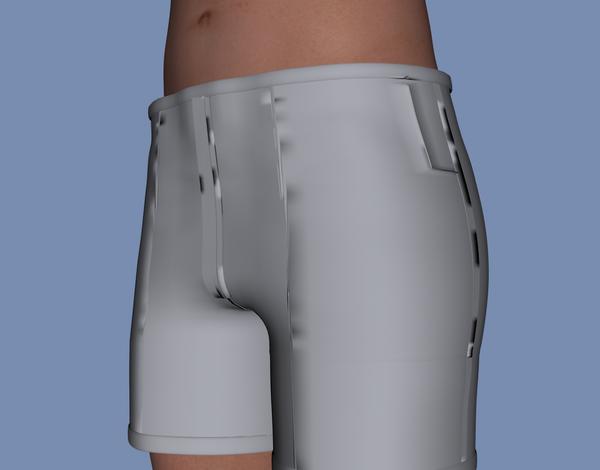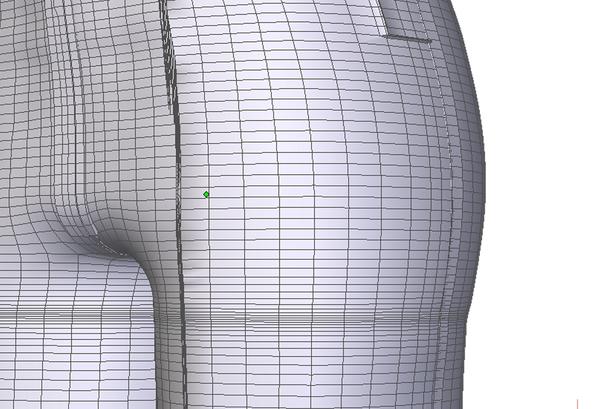Problems with black marks on hexagon modelled shorts
I am having problems with a pair of shorts I am modelling from Hexagon to Daz Studio...
I modelled the base shorts and then the waist band and seams seperately using the copy and paste with the thickness tool.
I then welded everything together and exported from Hexagon to DS.
As you can see from the second picture (below) the seams on the shorts have black bits on them - they are not there on the original.
I've been daft and saved my work with all the bits welded so i'm dreading someone telling me that the situation is not recoverable...
I have another query too.
If I model the clothing so that the body does not show through the fabric in Hexagon I find they are too big in DS. However if I tweak the materials ever so slightly the body shows through the fabric and it shows also in DS. Is there a sequence of thought I am not using when modelling? I am doing the rigging to the model but it just gets worse.
Any tips would be greatly appreciated... Thanks






Comments
Difficult to say, just looking - the seam down the front of the pants seems pretty messy with some poke-through and pinching.
The rendering artifacts could be caused by any of a number of things - flipped normals, N-gons, co-planar facets, non-manifold edges, etc.
I suggest you go through a process of elimination - in Hex, start with the selection menu - right down at the bottom there are some diagnostic tools. In turn, select over-4-points-faces, not-4-points-faces, non manifold edges, not-4-edges points. If there are any problems, these will be selected and you can fix.
Also try unifying normals to make sure all normals are pointing outwards.
Could also be crossing or overlapping UV's. Take a look at your UV map - in face mode, select all - if there are darker areas, you have overlaps which need to be fixed.
Be sure not to have bits of mesh poking through - the seam behind the pocket where most of the artifacts are doesn't appear to be properly welded - check that.
If none of these work, I'd suggest you post the model to somewhere like 4shared or dropbox and PM me the link so I can take a look at the actual mesh.
You beat me to it!!! :)
Also, Tdrd, you should know that welding parts does not neccessarily weld points, and non-planar quads can sometimes cause this along open (unwelded) edges.
Unify your normals first. If that doesn't work, then "average weld" your points and then unify your normals. One of these will work.
If you have to average weld points, be very careful - you have an extreme level of detail on those pants and so you have very little wiggle room on the "distance" setting. Setting it too high will cause polys to collapse. The default distance that shows up in the box is USUALLY safe and adequate, but you have to careful.
The best way is to watch the "face" count of your model. It must remain the same after average weld as before. If any point pairs were welded, your point count will drop, but the face count won't change.
Excuse me - I found a tutorial on flipping normals (seems appropriately named :-) ) amd tried to apply it to my shorts.
Everything is now inside out and I cannot for the life of me understand what it does....
Can anyone please explain in layman terms what flipping normals are...
Many thanks
Terry
A "normal" simply defines which way the polygon is "facing". If it's facing you, then it is visible. If it's facing away from you, then it's invisible.
The condition with your shorts is commonly called being "inside out", which simply means the normals are facing inwards relative to your model.
When you "unify" the normals, this simply makes all the normals face the same direction without regard to whether they are forward facing or backward facing.
If they're facing the wrong way, there's another widget on the "orient normals" window for flipping them called "reverse normals".
MAKING POCKETS AND PLEATS?
I thought i'd keep the topic on this same thread because it is relevant to the above.
I tried to make pockets by fast extruding a line but this does not seem to work very well.
I also tried to make another piece of material for a pocket but it's a curse to get the opposite working for the other side.
So has anyone any tips for putting realistic pleats and pockets onto pants please.
Thank you.
OK - I've had an opportunity to take a look at your file - can't go too much in depth right now, as I have to prepare for a meeting this morning.
Firstly, the artifacts are because of the method of making the seems and fly. There are a few flipped normals and quite a few N-gons, but they are not the cause of the artifacts.. I'll get to that later when I get back from my meeting.
What you have done with the seams and fly is to make matching mesh strips, with the facets up against the facets of the pants. These have been welded - not by vertex welding. This caused the facets to occupy the same space and in some cases intersect. When you apply a smoothing modifier in Studio, this would cause the seams to detach from the pants. When I stripped these out, the artifacts went away.
The method I would use would be to extract an edge loop, move it slightly away from the pants, offset it the width of the seam and make a mesh by joining the lines using ruled surface. Delete the facets of the pants under the new seam and bridge the seam into the pants. The seam could then be "hardened" by cutting in close extra edges.
For the pockets, I would extract the facets of the pants which would end up under the pockets, move the new form away from the pants the thickness of the pocket, shape it, then weld and bridge into place. Harden edges by cutting in extra close edges. This way you wouldn't end up with underlying facets that occupy the same space and intersect.
The seams and pockets would then be part of the pants and not separate when you apply the smoothing modifier.
Haven't had a chance to look at the creases - will let you have a fuller analysis later.:)
OK - I'm back:)
Completed the reconstruction by extracting the seams, pockets and fly, moving them slightly away from the pants, welding and bridging. Could have better shaped the pockets and fly, but they really need smoothing to get the best effect and the model is already way too poly-heavy. I did bring it down from 10K plus to 6K plus.
I'll PM you with a location to download the Hex file so you can take a look.
@Roygee: I am extremely impressed with what you have done with the pants. I did not expect that. Thank you for the detailed explanation and the time you have spent on my accord to resolve this problem.
BTW - they look impressive on the runner.
Terry
My pleasure:)
I have been helped so much by the community here over the years, so anything I can do to give back and maybe help another budding modeler to better understand the processes ...
Does that mean you can see skidmarks? (sorry - I just couldn't resist :)